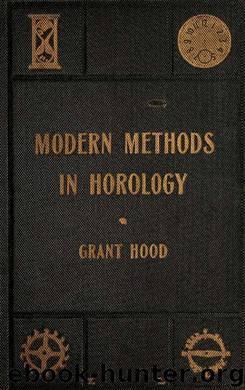Modern methods in horology by Hood Grant

Author:Hood, Grant
Language: eng
Format: epub
Tags: Clocks and watches
Publisher: Kansas City, Mo. : Kansas City Jeweler and Optician
Published: 1904-03-25T05:00:00+00:00
MODERN METHODS IN HOROLOGY.
THE LEVER ESCAPEMENT.
19. An angle is measured by the number of degrees contained between the two straight lines which form it.
20. A tangent to a circle is a straight line which touches the circle at only one point, and is always at right angles to a radius drawn to that point.
21. When two or more circles have the same center or are drawn from the same point, they are called concentric circles.
22. A degree is one of the 360 equal divisions of a circle. A half circle contains 180 degrees; a quarter circle 90 degrees, etc. The sizes of the degrees vary according to sizes of the circles.
23. A protractor is an instrument divided into degrees and half degrees, used for measuring or drawing angles.
The protractor and the degrees it is divided into must be well understood before we attempt to make our drawings. Every circle no matter how large or how small has 360 degrees; in other words, a degree is the 1-360 part of a circle. The degrees of a large circle will be large and those of small circles must be small. Degrees do not denote size but parts. A complete circle then has 360°, a half circle 360-^w^l80° one-fourth of a circle 360-^4=90°, etc. A protractor represents usually a half-circle, divided into 180 equal parts representing degrees, and in most cases these are sub-divided, giving % degrees; the center of the protractor should always be placed at the point from which we intend to lay off the degrees; to illustrate (Fig. 2) we have the horizontal line a-b. and the line perpendicular to it c-d. we wish to lay off 30° to the right and 30° to the left of the line c-d.; from point c. we place the protractor with its center at c; place a pencil dot at the 30° mark at the right, and the same on the left, then by drawing a straight line from c. through each of the dots, we have two lines, one 30° at the right of the line c-d, and the other 30° to the left or 60° from each other. No matter what the size of the circle that should be drawn, if these lines were continued our angles would be the same. For this reason, we are able to make a large drawing of an escapement or any part of it, ten, twenty or thirty times the actual size, and then reduce it to actual size very accurately.
Download
This site does not store any files on its server. We only index and link to content provided by other sites. Please contact the content providers to delete copyright contents if any and email us, we'll remove relevant links or contents immediately.
| Automotive | Engineering |
| Transportation |
Whiskies Galore by Ian Buxton(41720)
Introduction to Aircraft Design (Cambridge Aerospace Series) by John P. Fielding(33017)
Small Unmanned Fixed-wing Aircraft Design by Andrew J. Keane Andras Sobester James P. Scanlan & András Sóbester & James P. Scanlan(32685)
Craft Beer for the Homebrewer by Michael Agnew(18082)
Turbulence by E. J. Noyes(7895)
The Complete Stick Figure Physics Tutorials by Allen Sarah(7265)
Kaplan MCAT General Chemistry Review by Kaplan(6823)
The Thirst by Nesbo Jo(6759)
Bad Blood by John Carreyrou(6477)
Modelling of Convective Heat and Mass Transfer in Rotating Flows by Igor V. Shevchuk(6354)
Learning SQL by Alan Beaulieu(6159)
Weapons of Math Destruction by Cathy O'Neil(6085)
Man-made Catastrophes and Risk Information Concealment by Dmitry Chernov & Didier Sornette(5878)
Digital Minimalism by Cal Newport;(5588)
Life 3.0: Being Human in the Age of Artificial Intelligence by Tegmark Max(5405)
iGen by Jean M. Twenge(5326)
Secrets of Antigravity Propulsion: Tesla, UFOs, and Classified Aerospace Technology by Ph.D. Paul A. Laviolette(5237)
Design of Trajectory Optimization Approach for Space Maneuver Vehicle Skip Entry Problems by Runqi Chai & Al Savvaris & Antonios Tsourdos & Senchun Chai(4957)
Electronic Devices & Circuits by Jacob Millman & Christos C. Halkias(4865)
